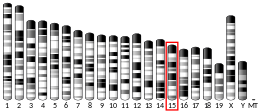Nucleoporin 155 (Nup155) is a protein that in humans is encoded by the NUP155 gene.[5][6]
Nucleoporins are the main components of the nuclear pore complex (NPC) of eukaryotic cells. They are involved in the bidirectional trafficking of molecules, especially mRNAs and proteins, between the nucleus and the cytoplasm. The protein encoded by this gene does not contain the typical FG repeat sequences found in most vertebrate nucleoporins. Two protein isoforms are encoded by transcript variants of this gene.[6]
Interactions
editReferences
edit- ^ a b c GRCh38: Ensembl release 89: ENSG00000113569 – Ensembl, May 2017
- ^ a b c GRCm38: Ensembl release 89: ENSMUSG00000022142 – Ensembl, May 2017
- ^ "Human PubMed Reference:". National Center for Biotechnology Information, U.S. National Library of Medicine.
- ^ "Mouse PubMed Reference:". National Center for Biotechnology Information, U.S. National Library of Medicine.
- ^ Zhang X, Yang H, Corydon MJ, Zhang X, Pedersen S, Korenberg JR, Chen XN, Laporte J, Gregersen N, Niebuhr E, Liu G, Bolund L (Jun 1999). "Localization of a human nucleoporin 155 gene (NUP155) to the 5p13 region and cloning of its cDNA". Genomics. 57 (1): 144–51. doi:10.1006/geno.1999.5741. PMID 10191094.
- ^ a b "Entrez Gene: NUP155 nucleoporin 155kDa".
- ^ Rayala, Heidi J; Kendirgi Frederic; Barry Dianne M; Majerus Philip W; Wente Susan R (Feb 2004). "The mRNA export factor human Gle1 interacts with the nuclear pore complex protein Nup155". Mol. Cell. Proteomics. 3 (2). United States: 145–55. doi:10.1074/mcp.M300106-MCP200. ISSN 1535-9476. PMID 14645504.
Further reading
edit- Görlich D, Mattaj IW (1996). "Nucleocytoplasmic transport". Science. 271 (5255): 1513–8. Bibcode:1996Sci...271.1513G. doi:10.1126/science.271.5255.1513. hdl:11858/00-001M-0000-002D-1CAE-4. PMID 8599106.
- Nagase T, Ishikawa K, Suyama M, et al. (1999). "Prediction of the coding sequences of unidentified human genes. XI. The complete sequences of 100 new cDNA clones from brain which code for large proteins in vitro". DNA Res. 5 (5): 277–86. doi:10.1093/dnares/5.5.277. PMID 9872452.
- Zhang X, Yang H, Yu J, et al. (2002). "Genomic organization, transcript variants and comparative analysis of the human nucleoporin 155 (NUP155) gene". Gene. 288 (1–2): 9–18. doi:10.1016/S0378-1119(02)00470-5. PMID 12034489.
- Strausberg RL, Feingold EA, Grouse LH, et al. (2003). "Generation and initial analysis of more than 15,000 full-length human and mouse cDNA sequences". Proc. Natl. Acad. Sci. U.S.A. 99 (26): 16899–903. Bibcode:2002PNAS...9916899M. doi:10.1073/pnas.242603899. PMC 139241. PMID 12477932.
- Rayala HJ, Kendirgi F, Barry DM, et al. (2004). "The mRNA export factor human Gle1 interacts with the nuclear pore complex protein Nup155". Mol. Cell. Proteomics. 3 (2): 145–55. doi:10.1074/mcp.M300106-MCP200. PMID 14645504.
- Ota T, Suzuki Y, Nishikawa T, et al. (2004). "Complete sequencing and characterization of 21,243 full-length human cDNAs". Nat. Genet. 36 (1): 40–5. doi:10.1038/ng1285. PMID 14702039.
- Colland F, Jacq X, Trouplin V, et al. (2004). "Functional Proteomics Mapping of a Human Signaling Pathway". Genome Res. 14 (7): 1324–32. doi:10.1101/gr.2334104. PMC 442148. PMID 15231748.
- Gerhard DS, Wagner L, Feingold EA, et al. (2004). "The Status, Quality, and Expansion of the NIH Full-Length cDNA Project: The Mammalian Gene Collection (MGC)". Genome Res. 14 (10B): 2121–7. doi:10.1101/gr.2596504. PMC 528928. PMID 15489334.
- Hawryluk-Gara LA, Shibuya EK, Wozniak RW (2005). "Vertebrate Nup53 Interacts with the Nuclear Lamina and Is Required for the Assembly of a Nup93-containing Complex". Mol. Biol. Cell. 16 (5): 2382–94. doi:10.1091/mbc.E04-10-0857. PMC 1087243. PMID 15703211.
- Rual JF, Venkatesan K, Hao T, et al. (2005). "Towards a proteome-scale map of the human protein-protein interaction network". Nature. 437 (7062): 1173–8. Bibcode:2005Natur.437.1173R. doi:10.1038/nature04209. PMID 16189514. S2CID 4427026.




